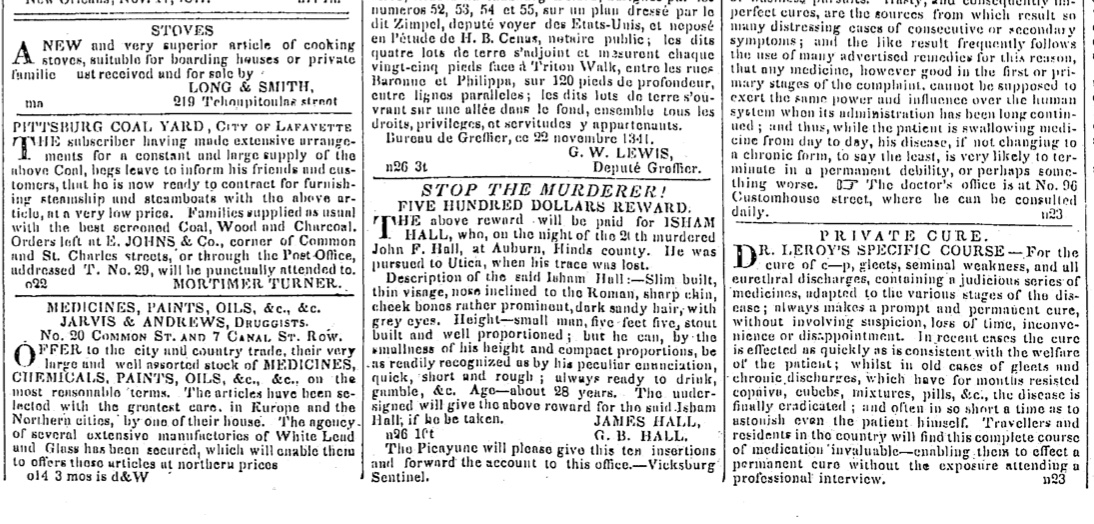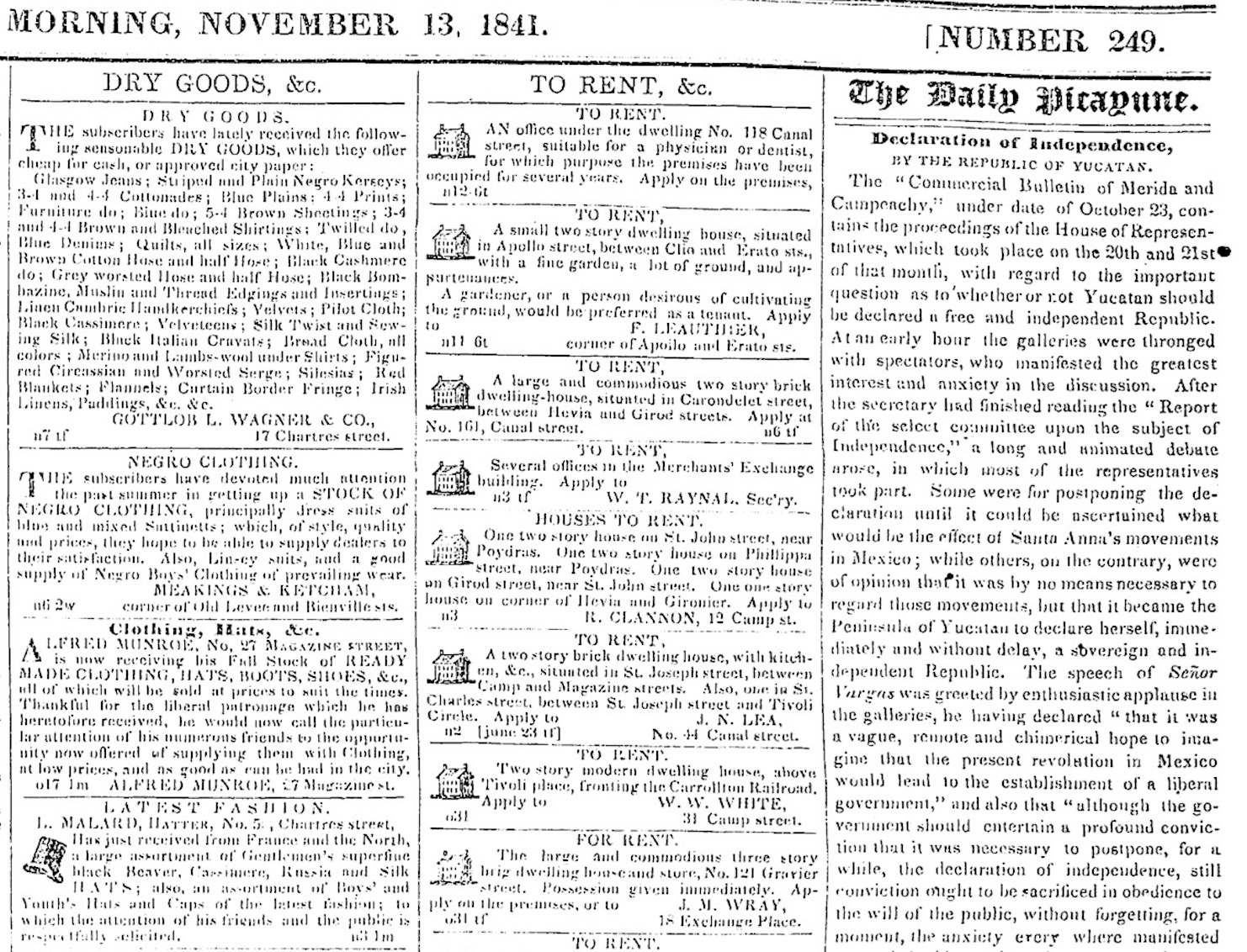A wide range of topics is found in the archives of the Times-Picayune newspaper from November 1841. Poems precede a transcript of the Declaration of Independence from Yucatan; found in-between ads for groceries, notices for theater productions, and wanted ads for occupations like nannies or tutors (From the Times-Picayune archives, November 1841). Articles about a murder suspect or current events in Britain are scattered throughout the pages. What the paper lacks in organization, it makes up for in the sheer quantity of information presented. Comparisons can be drawn between this disorganized style of news presentation and the common practices of supervising children in 1800s New Orleans. Between the trend of having multiple children as a way to improve social standing to testimonials from children about frequent downtime and trying to stay out of adults’ way, New Orleans families in 1841 emphasized sheer quantity over organized quality, similar to the presentation of information in the 1841 Times-Picayune.
In the decades leading up to the Civil War, having a large family was important in New Orleanian society. More children granted a mother and a family more opportunities to improve their social standing by marrying daughters into wealthier families or molding sons into contributing members of society. In 1841, however, childbirth was not guaranteed to be a smooth experience for either the infant or the mother. This was especially true when considering the number of children women were expected to have in their lifetime. According to a Journal of Louisiana History report, “many mothers bore children continuously, stopping only with age or death.” This coincides with the fact that the average U.S. mother had eight children in 1800, and many state legislatures began banning the sale of contraceptives in the 1840s. Men in New Orleans were also particular about the sex of their children, typically preferring boys to girls. Oftentimes, this created unnecessary pressure on the mother to continue having children until she bore a boy.
However, New Orleans mothers were slightly better off than other Southern mothers at the time because of their proximity to a large city. The proximity allowed them to have quicker travel times to see doctors and access adequate medicine. New Orleans’ unique European influences further aided mothers and children at the time, as international doctors and varying medical trends came to New Orleans. As a result, New Orlenian mothers could throw a host of professionals, strategies, and practices at the topic of infant care, hoping that some combination helped keep their many children alive. Throwing differing ideas together to accomplish something was also a practice the editors of the Times-Picayune employed, putting notices for book sales and Virginia tobacco deliveries into a corner of one page next to a biography of a Canal Street doctor (From the Times-Picayune archives, November 1841).
However, the emphasis on large families and the range of medical professionals and services available did not always translate into benefits for New Orleanian children in the antebellum period. Jobs available for women in New Orleans were rare and low-paying, so single mothers often lacked the funds to care for children, forcing some to leave babies on doorsteps. City legislation also viewed men to be in familial control, so mothers without spouses were unable to receive public support legally and were forced to turn to a private solution like orphanages. New Orleans law in 1841 stated that men were the “masters” of their own family, and their word was final regarding any actions carried out by the family, including child raising. Yet even with the disproportionate control over their family’s behaviors, fathers often had a distant and indifferent approach to their young children. Some fathers did not even come to see the birth of their child, choosing instead to stay at work or away from home. Mothers were tasked with keeping infants safe, protecting them from a range of dangers like yellow fever, fires, or even wild dogs on the streets, while fathers enjoyed the benefits of bestowed legal authority. This contrast of definitive gender roles in childcare and an emphasis on large families illustrates the complexity of family raising in New Orleans hundreds of years ago, a complexity reflected in turn by the organization of the city’s newspaper.
New Orleanian mothers spent most of their time having and caring for small children. They spent much less time caring for and watching older children and adolescents, often because they were busy with another baby. This, coupled with the lack of child-rearing activities taken on by many fathers, resulted in older children being unsupervised for most of the day and required to stay out of the way of adult business. Testimonials describe how children spent their days playing in nature, on riverbanks, or on the wide neutral grounds between city avenues. Dance classes were held to provide some forms of stimulation and structure, but were not daily occurrences. Trips down to the French Market were highlights for wealthier white Uptown children. Parties or other formal gatherings with groups of other children were rare, and the emphasis on staying quiet and out of trouble was ingrained into the minds of New Orleans children. Children were told what not to do and then asked to entertain themselves in their homes or neighborhoods. The lack of consistent adult supervision of older children and the need for the individual to make sense of the world around them is similar to the structure of the Times-Picayune; the paper lacks an organized structure and places the responsibility on the reader to learn something from the information provided.

Piece from Times-Picayune archives of November, 1841
In 1841, the organization of the Times-Picayune was as haphazard as the structure of New Orleanian families at the time. One front page of the Times-Picayune runs through several topics in just one corner of the paper, almost as if the editors forgot about the three additional pages they could have written on (from the Times-Picayune archives, November 1841). Headlines attempt to organize the topics, but broad categories such as ‘Notices’ or ‘State of the City’ do not allow for much specificity. By the fourth paragraph in the “Dry Goods” section, the paper has transitioned into fashion trends from France that have just come to the U.S. (From the Times-Picayune archives, November 1841).

Piece from Times-Picayune archives of November, 1841
While technically a dry good, it does not notify the reader of where to buy these clothes or what is in town. The variance within the column carries over onto other pages, where rental opportunities and a copy of the Declaration of Independence from Yucatan can also be found (From the Times-Picayune archives, November 1841). Like the method of mothers having children until “age or death,” the editors of the Times-Picayune showed no signs of restraint when deciding what to include on the pages.
TThe newspaper organization style is found throughout all issues of the Times-Picayune in November of 1841 (From the Times-Picayune archives, November 1841). It provides evidence that subscribers and editors were more interested in simply producing large amounts of information and being informed rather than being able to find specific information efficiently. In a way, the concept of family planning and childcare in New Orleans in 1841 represented a similar strategy of emphasizing quantity over recognizable supervision. Mothers continued to have children to increase their opportunities of improving the family reputation. Fathers used their authority as legal masters of the home to ensure their children, preferably sons, became functioning members of society. Supervising older children was less important, although strict rules and guidelines were imparted to the children to keep them in check. Daily activities for children at the time were often spontaneous and relied on self-entertainment. For both the Times-Picayune, entrusted with informing their subscribers on a wide range of local, domestic, and international issues, and for those entrusted with raising a child, a clear organized structure was often sacrificed to meet the predefined objective.
This piece was edited by Anna Blavatnik as part of Professor Kelley Crawford’s Digital Civic Engagement course at Tulane University.
 NOLAbeings
Multimedia artist Claire Bangser created NOLAbeings as a portrait-based story project that marries...
NOLAbeings
Multimedia artist Claire Bangser created NOLAbeings as a portrait-based story project that marries...
 Data corner: Adobe Suite (create a PDF, social media graphic, presentation, edit a photo and video
Data corner is where you go to work with analytics and top tech skills. It takes on everything from PERL and SQL to Canva and Sprout Social.
Data corner: Adobe Suite (create a PDF, social media graphic, presentation, edit a photo and video
Data corner is where you go to work with analytics and top tech skills. It takes on everything from PERL and SQL to Canva and Sprout Social.
